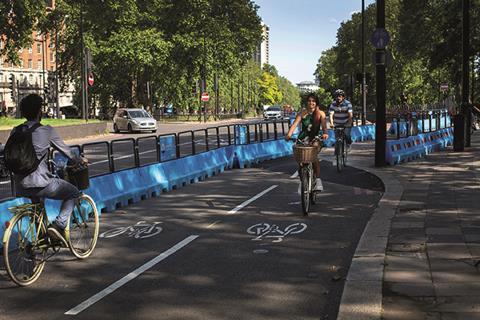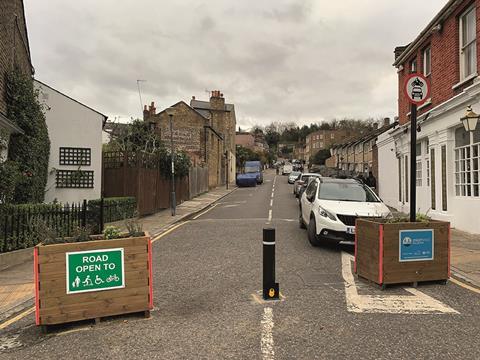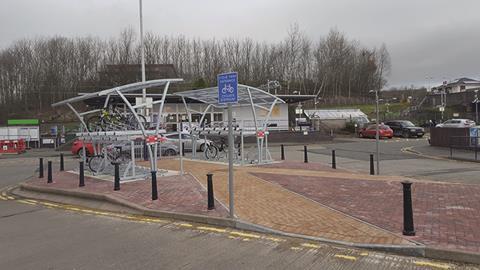The first lockdown gave us a vision of a low-traffic future, with walking and cycling gaining prominence. That promise could soon become a reality with accelerated investment in the infrastructure required for active travel, to engineer daily exercise back into our lives

01 / Introduction
Active travel, particularly walking and cycling, is known to be the single most effective solution to ill health in UK cities. Poor public health resulting from lack of exercise is a major problem. In Manchester alone, inactivity costs £6.4bn a year in avoidable healthcare costs, and lack of exercise contributes to one in six deaths. Unfortunately, exercise and active travel have been engineered out of daily life. As experience in the Netherlands has shown, turning the situation around requires a long-term, strategic effort.
High levels of congestion, noise and air pollution on streets are a huge turn-off for pedestrians and cyclists. As an example, in a survey for the London Cycling Action Plan, only 31% of respondents had exercised twice for more than 10 minutes on the previous day. Fixing problems associated with high volumes of traffic and unwelcoming streets is an important step in promoting active travel to deliver healthier cities.
The momentum behind active travel, which includes use of public transport, has been building for a while. It is a key transport policy plank in cities such as London and Manchester as well as in Scotland and Wales, where legislation was passed in 2013 to promote active travel. Existing high-profile schemes such as the Mini-Holland projects in London have generated an evidence base for active travel investment.
Covid-19, however, has proven to be the game-changer. The first lockdown gave city residents an unexpected opportunity to experience traffic-free streets and clean air, and government doubled down on the opportunity with the accelerated launch of a £2bn active travel programme. This included emergency funding of £225m, announced in May, to create pop-up cycle lanes, wider pavements, and safer junctions.
Regrettably, traffic levels in many cities have now returned to pre-covid-19 levels. Furthermore, some of the temporary active travel schemes hastily introduced during lockdown have not been well received. Low levels of consultation have often been a problem, given the fast turnaround. This experience highlights the complexity of the local politics associated with urban travel and shows how car use is embedded in many people’s lives. Criticism of active travel has a high profile in parts of the media, which is threatening the reputation of the wider active travel programme.
However, this will not mean the premature end of such initiatives. The government’s Gear Change policy will tie future funding of road investment to active travel targets. All local authorities will need to consider pedestrians and cyclists in their road planning. Encouragingly, experience from well-established schemes highlights that real benefits are secured for locals and that displacement of traffic is not as great as feared. As a result, opposition tends to fall over time. Feedback from these pilots does, however, highlight the intricate nature of scheme design, particularly with respect to impact on the wider neighbourhood. High-quality design combined with effective consultation is essential to secure buy-in and address the concerns of all street users.
With a second tranche of the government’s emergency active travel funding due to be launched shortly, it is vital not only that local authorities learn the lessons of the first phase, but also that future plans are more joined up so as to make a real difference to street users.
02 / What is active travel?
Active travel describes a set of transport policies that give greater emphasis to the needs of pedestrians and cyclists over motorists. The aim is to make it easier to walk, ride or work remotely rather than travel by car. Active travel infrastructure includes segregated bike lanes, pavement extensions, controlled junctions, traffic filters and road calming. The best active travel schemes form part of a well-designed public realm that creates liveable neighbourhoods. Other measures designed specifically to support and encourage the uptake of cycling include investment in digital maps, better wayfinding and secure bike parking, all of which can make cycling more attractive for a wider range of people.
The Netherlands is the world leader in active travel, benefiting from farsighted planning over the past 50 years. Some 16% of its road network is cycle paths, and an amazing 30% of all trips under 7.5km are cycled. By contrast, in the UK only 11% of adults ride a bike once a week.
Although European cities such as Amsterdam and Copenhagen have long-established active travel strategies, experience elsewhere shows it is possible to catch up. Portland, in the US state of Oregon, for example, has seen a 20% reduction in car traffic since it started investing in provision for bikes in the 1990s, a change that has coincided with Portland’s regeneration as a technology hub.
The active travel approach is best described by the principles of Healthy Streets, an initiative first developed by Transport for London (TfL) in 2014 and which is now embedded in the London Plan. The approach is underpinned by 10 indicators that are used to understand what makes streets appealing, healthy and inclusive places. They include clean air, streets that are not too noisy and are easy to cross, shade and shelter, and things to see and do.
The Healthy Streets approach is not one-size-fits-all. There is no one definition of healthy or unhealthy streets. However, it does show how a consistent approach to the problem can deliver a much-improved local experience. TfL has applied Healthy Streets principles to major transport schemes such as Archway, Highbury, and Old Street, delivering much-improved places in the process.
Individual active travel schemes should ideally be considered as part of a wider system of interventions; problems are more likely without this. For example, while London’s Cycle Superhighways have been instrumental in increasing the volume of London cycle commuter traffic, the policy behind them has been criticised for not addressing the needs of cyclists away from the trunk routes.
Manchester’s £160m Bee Network, promoted by the mayor and regional transport authorities, proposes to create a 1,000-mile network based mostly on quiet residential streets. By contrast, in London most of the new active travel investment is being delivered at a borough level and is less co-ordinated as a result.
When schemes are not planned across borough boundaries, they can result in unintended disruption and congestion. Recent low-traffic neighbourhood (LTN) projects in Lee Green, which falls into both Lewisham and Greenwich boroughs, have been heavily criticised for not addressing boundary issues.
Manchester‚Äôs Bee Network strategy also aligns neatly with efforts to reduce traffic on residential roads, which is what led to the development of the LTN idea. The exponential growth in use of satnav in the past 10-15 years has resulted in traffic diverting from already congested main roads, creating ‚Äúrat runs‚ÄĚ on previously quiet residential streets. In many neighbourhoods, LTN campaigns are as much about reclaiming residential streets from the traffic that has grown in the past decade as they are about reallocating road space away from cars to pedestrians and cyclists.

03 / The business case for active travel
Improved health outcomes are the main driver behind active travel policies. Typically, schemes are aimed at encouraging car users to change their behaviour as well as supporting existing cyclists and pedestrians. There are also wider social and economic drivers from the Healthy Streets strategy. The government’s recent Gear Change policy highlights climate change, congestion, road safety and inequality as well as health outcomes as the drivers behind the new, national £2bn programme.
Poor air quality in UK towns and cities is reckoned to cause 40,000 premature deaths a year, at an annual social cost of £22bn. Communities exposed to the worst quality air typically have a lower level of car ownership, so are paying the price for the mobility of other road users. Manchester has calculated that the annual cost of the status quo in terms of congestion, air quality, road accident casualties and lack of exercise is over £3.5bn.
To be successful, schemes need to directly benefit users, particularly local residents whose daily lives might be negatively affected by changes to road layouts or loss of parking. In many cases, local benefits are compelling. Data from established schemes such as the Mini-Hollands in London, for example, shows local businesses benefit from higher sales as a result of the extra journeys by pedestrians and cyclists, and that traffic on local roads falls by about 50%. Over time, the use of active travel infrastructure gradually increases, and local support grows. The benefit/cost ratio is 13:1, which is four times higher than for most road schemes.
A key concern about individual schemes is the fear that they will displace traffic from one area to another. This is particularly important for residents on roads immediately outside a scheme. The plentiful research into this has found evidence that overall traffic levels fall as a result of ‚Äúevaporation‚ÄĚ as more people choose to walk or cycle for short journeys. The Walthamstow Village low-traffic neighbourhood is widely quoted as a scheme that reduced traffic levels and speeds on residential roads, and which resulted in only marginal traffic increases outside its boundary.
04 / Active travel policies ‚Äď what is being proposed?
Active travel is largely a local authority issue. Local delivery inevitably means there is a degree of variation in policies and prioritisation. The London borough of Kensington and Chelsea, for example, has a much less extensive active travel network compared with other inner London boroughs.
In an effort to kick-start a more consistent approach to active travel development, the government launched its Gear Change policy in July 2020, promising £2bn of funding over 10 years as part of a wider £5bn programme of public transport investment.
The vision of Gear Change goes beyond safer streets and convenient, accessible travel to promote the idea of active travel as a route to healthier, happier, greener communities. Importantly, the policy places active travel at the heart of all transport planning. In future, only transport schemes that comply with policy requirements will receive funding. Gear Change has four main themes:
- Better streets. This policy theme describes a much more proactive approach to the rebalancing of priorities between cars and other street users. One example of this shift in priorities is the commitment to fund only segregated bike lanes on busy roads. Painted bike lanes will no longer be funded, meaning that more road space will be reallocated to bikes and pedestrians as the policy is implemented.
- Active travel at the heart of policy-making. In addition to a sixfold increase in funding, a new body, Active Travel England (ATE), will be established as a statutory consultee for local plans and transport schemes. Future transport investment business cases will take account of benefits to cyclists and pedestrians.
- Empowered local authorities. This theme covers the long-term funding settlement, the support of ATE and the transfer of traffic management powers to local authorities. Local authorities will be held accountable by having their transport investment funding allocated against active travel performance.
- Enable and protect cyclists. This strand includes the eye-catching policy of GPs prescribing cycling on the NHS as well as a much‚ÄĎexpanded training and support package. Changes to the Highway Code will also provide greater protection to pedestrians and cyclists.
Overall, the strategy embeds many of the changes that authorities such as TfL and Transport for Greater Manchester have called for in their own local strategies. Long-term funding, reprioritised transport investment, devolved powers and increased public access to bikes all feature in their plans. For once, it appears that the interests of central government and devolved regional administrations are properly aligned.
Local politics remain problematic. The fast implementation of many LTN schemes in response to emergency funding has left many communities feeling that they have not been fully consulted. Furthermore, the rapid withdrawal of some poorly implemented schemes this year has given the impression that the policy is a local initiative rather than a national strategy. Given the scale of the problems that active travel seeks to address, it is vital that schemes are developed coherently and are given enough time to bed in.
Long-term investment in resources to support local authorities will be a critical part of the scheme. Given the range of negative penalties built into the strategy, including time-limited funding, local authorities will need extra support to be able to make best use of the funding becoming available through Gear Change. One key to unlocking future funding will be the willingness of local authorities to build the specialist design resource capability required to deliver Dutch-quality active travel infrastructure.
Mixed results coming from the first tranche of emergency active travel investments highlight the importance of high-quality design and consultation work. Local authorities that perform well in these areas are likely to secure more funding and to be able to deliver more ambitious plans on behalf of their citizens.
As traffic levels return to pre-pandemic levels, it is increasingly clear that current patterns of road use are unsustainable. However, as has become evident following the rapid implementation of active travel schemes during 2020, interventions need to be carefully planned on a large-area basis, supported by proactive consultation. This approach will avoid some of the challenges illustrated by the case studies (see opposite page), for example when the full benefits of an investment are not realised, or when a community is not engaged with the development of local plans.
Case study: Bowes area low-traffic neighbourhood
The Bowes area LTN has recently been introduced as a trial scheme supported by emergency active travel funding. The proposals have been developed by Enfield council as part of its Cycle Enfield strategy, following a campaign by residents. Bowes Park is hemmed in by traffic arteries, and NO2 air pollution levels in local schools exceed WHO guidelines. Problems in the area date back to 2012 following the implementation of a journey time improvement scheme on the neighbouring North Circular road, which displaced trunk road traffic onto residential roads. Initial suggestions were developed by residents with support from a Better Streets campaign group. The final plans were approved by the council in summer 2019.
The proposals have been supported by a campaign by the local MP and a perception survey. However, wider consultation is being run in parallel with the trial. In practice, securing engagement is difficult and the implementation of the scheme has been met by vocal opposition.
Experience from other schemes highlights that opposition can be loud and uncomfortable. Support is often drawn from outside groups that are hostile in principle to active travel measures. Local authorities such as Enfield will need to hold their nerve if such changes are to realise their long-term health objectives.
The experience of the Bowes Area LTN is that an area-based approach is essential ‚Äď otherwise one-off adjustments simply displace the traffic from one residential road to another. Furthermore, such an approach needs to extend across borough boundaries, as most challenging roads are often on a boundary. By adopting a ‚Äúno street left behind‚ÄĚ approach, residents hope to be able to extend the scope of the scheme in the near future.

Case study: Station travel planning
Abellio ScotRail has commissioned Arcadis to undertake 18 station travel plans (STPs) aimed at increasing sustainable travel to the rail network, reducing dependence on single-occupancy car journeys. The studies involved detailed site audits identifying opportunities and barriers to last-mile trips as well as extensive stakeholder and user engagement, including the use of online surveys.
One of the major findings of the study was that although ScotRail has made a significant investment in improving the quality and quantity of bike parking at stations, there has been a very mixed picture with respect to the use of the new facilities. The take-up of some facilities has been very high, but this is not the case everywhere, which highlights the complex factors influencing active travel choices. Most of the barriers to increased cycling and walking to the station resulted from a lack of joined-up and segregated cycle routes, caused in some cases by land ownership issues and sometimes exacerbated by local topography.
The updated STPs included a range of improvements requiring action by a number of parties, including the local authority. This finding highlights the need for an integrated approach to active travel planning. Isolated investments by individual organisations are a positive step forward but rely on complementary programmes by partners such as the local authority.
Transport Scotland’s Places for Everyone strategy has been in place since 2010, and for ScotRail the dominance of single-occupancy cars for trips to the station has been a longstanding issue. The STP programme has offered a great chance to really drill down into the reasons for car journeys being made to stations and how to effect change.
With a greater active travel knowledge base being developed across the UK by projects such as the STPs, schemes in all regions will benefit from a better understanding of the factors that contribute to a successful investment.

05 / Conclusions
With the launch of a well-funded £2bn active travel strategy, the UK is finally in a good position to start to make progress in this critical area of health and wellbeing. The new design guidance, LTN 1/20, sets out improved design expectations and the newly established Active Travel England will have a crucial role to play as an Ofsted-type body to assure the quality of proposals.
The prime minister, Boris Johnson, is personally invested in creating a UK cycling revolution but acutely aware of the need to navigate negative tabloid headlines. Change will require political will at a local level, which is best supported through a consistent, well-funded implementation plan. Looking forward, the ¬£257m funding award for active travel for 2021/22 ahead of a future long-term spending review is a firm foundation on which to build momentum on the journey to ‚Äúgo Dutch‚ÄĚ.
Acknowledgments
The authors would like to thank Keri Stewart and Matt Kitching of Arcadis and Desmond Bradley of ScotRail for their contributions to this article.
























No comments yet